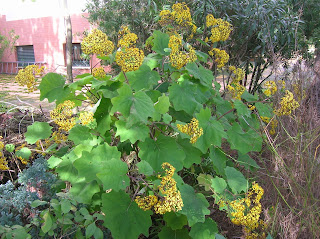




SENNA DIDYMOBOTRYA (sin. Cassia didymobotrya)
Origen: Africa tropical
Es un arbusto de gran tamaño que puede alcanzar más de tres metros de alto por otros tantos de ancho.
Las hojas, al ser frotadas, exhalan un olor muy parecido al de los "kikos" o al de las palomitas de maíz, de ahí su nombre anglosajón.
Florece desde finales de invierno hasta cerca del verano y luego esporádicamente hasta la llegada de los fríos. Los capullos empiezan a formarse en invierno por lo que el frío perjudica notablemente la floración.
Se reproduce por esquejes o semillas aunque es difícil conseguirlas fuera de latitudes subtropicales.
Sólo soporta heladas muy débiles. Por debajo de dos grados bajo cero los tallos se queman y, como hemos dicho, se estropea la floración, aunque nuevos tallos rebrotan al llegar el buen tiempo.
English version:
Origin: Tropical Africa
Common name: Popcorn Cassia, Peanut Butter Cassia
It´s a big shrub that grows to more than 3 metres high and wide.
Leaves, when crushed, have a smell similar to popcorn, hence its common name.
It flowers from late winter to summer, and later sporadically until cold temperatures come. Blooms begin to grow in winter so low temperatures damages seriously flowering.
Propagation is from cuttings or seeds but they´re difficult to get outside subtropical climates.
It withstands only light frosts. Temperatures below 28º F kill all the blooms and many stems, but new ones resprout when spring comes.






















































